Podcast
Questions and Answers
Match the blood components with their primary functions:
Match the blood components with their primary functions:
Plasma = Transports nutrients and hormones Red Blood Cells = Transports oxygen Platelets = Reduces chance of infection White Blood Cells = Fights infection
Match the type of blood cell with its specific characteristics:
Match the type of blood cell with its specific characteristics:
Red Blood Cells = No nucleus, biconcave shape Platelets = Protein fragments that collect blood White Blood Cells = Produces antibodies Lymphocytes = Nucleus present, fights diseases
Match the blood components with their percentage in blood:
Match the blood components with their percentage in blood:
Plasma = 55% Red Blood Cells = 45% Platelets = Less than 1% White Blood Cells = Less than 1%
Match each blood cell type with its primary action:
Match each blood cell type with its primary action:
Match the following blood components with their production site:
Match the following blood components with their production site:
Flashcards
Plasma's role
Plasma's role
Plasma is the liquid part of blood that carries dissolved substances like oxygen, nutrients, and hormones throughout the body.
Red Blood Cells function
Red Blood Cells function
Red blood cells carry oxygen to the body's tissues. Red blood cells contain hemoglobin which binds with oxygen for transport.
Platelets' function
Platelets' function
Platelets help stop bleeding by collecting at a wound.
White blood cells' role
White blood cells' role
Signup and view all the flashcards
Red Blood Cell shape
Red Blood Cell shape
Signup and view all the flashcards
Study Notes
Blood Components
- Plasma (55%): The liquid part of blood, allowing substances to dissolve in it, enabling transport.
- Blood components (45%):
- Red blood cells
- White blood cells
- Platelets
Plasma Function
- Transport:
- Oxygen
- Nutrients (glucose + amino acids)
- Hormones
Platelets
- Function:
- Containing protein fragments
- Reduce the chance of infection
Red Blood Cells
- Function:
- Transport oxygen
- Production: Bone marrow
- Structure:
- Biconcave shape (hollow center)
- Increases surface area enabling better oxygen attachment to hemoglobin
- Flexible, allowing movement in and out of capillaries
- Hemoglobin: Contains iron allowing oxygen to attach to RBC
- No Nucleus: Prokaryotic
White Blood Cells
- Function:
- Fight infection
- Production: Bone marrow
- Function:
- Produce antibodies
- Attack/digest pathogens
Types of White Blood Cells
- Lymphocytes: Produce antibodies
- Nucleus present
- Monocyte/Phagocyte:
- Cytoplasm surrounds pathogens
- Nucleus present
Studying That Suits You
Use AI to generate personalized quizzes and flashcards to suit your learning preferences.




